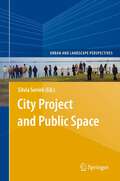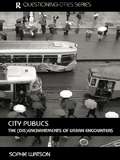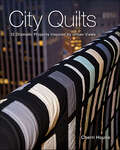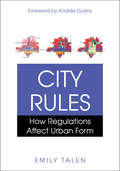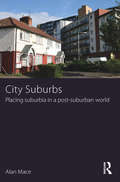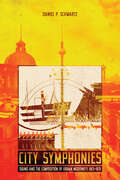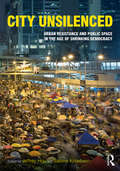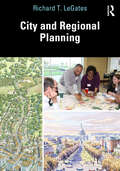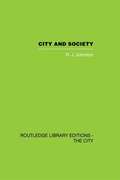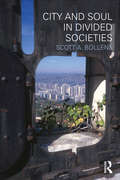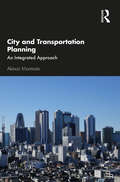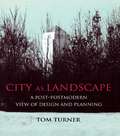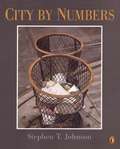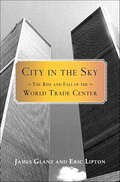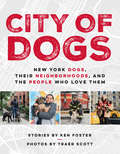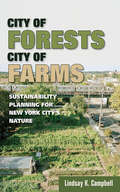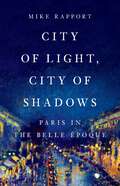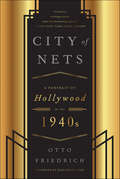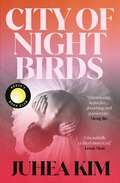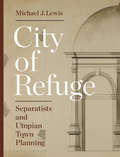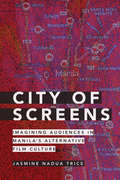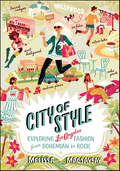- Table View
- List View
City Project and Public Space (Urban and Landscape Perspectives #14)
by Silvia SerreliThe book aims at nurturing theoretic reflection on the city and the territory and working out and applying methods and techniques for improving our physical and social landscapes. The main issue is developed around the projectual dimension, with the objective of visualising both the city and the territory from a particular viewpoint, which singles out the territorial dimension as the city's space of communication and negotiation. Issues that characterise the dynamics of city development will be faced, such as the new, fresh relations between urban societies and physical space, the right to the city, urban equity, the project for the physical city as a means to reveal civitas, signs of new social cohesiveness, the sense of contemporary public space and the sustainability of urban development. Authors have been invited to explore topics that feature a pluralism of disciplinary contributions studying formal and informal practices on the project for the city and seeking conceptual and operative categories capable of understanding and facing the problems inherent in the profound transformations of contemporary urban landscapes.
City Publics: The (Dis)enchantments of Urban Encounters (Questioning Cities)
by Sophie WatsonSome cities have grown into mega cities and some into uncontrolled sprawl; others have seen their centres decline with populations moving to the suburbs. In such times, questions of the public realm and public space in cities warrant even greater attention than previously received. Concerned with the borders and boundaries, constraints and limits on accepting, acknowledging and celebrating difference in public, Sophie Watson, through ethnographic studies, interrogates how difference is negotiated and performed. Focusing on spaces where to outside observers tension is relatively absent or invisible, Watson also reveals how the boundaries between the public and private are being negotiated and redrawn, and how public and private spaces are mutually constitutive. Through her investigation of the more ordinary and less dramatic forms of encounter and contestation in the city, Watson is able to conceive an urban public realm and urban public space that is heterogeneous and potentially progressive. With numerous photographs and drawings City Publics not only throws new light on encounters with others in public space, but also destabilizes dominant, sometimes simplistic, universalized accounts and helps us re-imagine urban public space as a site of potentiality, difference, and enchanted encounters.
City Quilts: 12 Dramatic Projects Inspired By Urban Views
by Cherri HouseDiscover Endless Design Possibilities in Everything from Parks to Parking Lots! • Create city-inspired quilts by piecing together simple geometric shapes • Beginner-friendly project designs are inspired by modern urban architecture and landscapes • Learn how to achieve dramatic looks with more effective use of color, value, and placement • Work with traditional blocks like Flying Geese and Log Cabin in a new way Turn your love of urban cityscapes into beautiful quilts. In this book, you'll discover the secrets of minimalist design-how to find beauty in the basic elements of your environment. These projects deliver exciting, vivid results with solid color fabrics. City Quilts was named one of the Best Books of 2010 in the Fiber Crafts Category by Library Journal, and is a finalist in the 2010 Foreword Book of the Year Awards.
City Responses to Disruptions in 2020: From Lockdowns to Aftermath (Advances in 21st Century Human Settlements)
by Bharat Dahiya Giuseppe T. CirellaThis book presents the integrating of economics and urban geography to create a framework of cooperation around the idea of urban economic stability. It explores these disciplines through the economic lens and creates a collaborative environment for addressing the global challenges caused by the COVID-19 pandemic and future global shocks. Environmental advocates and proponents of economic growth are increasingly at odds—having looked at the economic impact of the decline of the environment as well as the environmental loss that occurs with unchecked growth and urbanization. The outbreak of the COVID-19 pandemic changed the global scene. The world shook in its foundations, as a number of countries’ lockdown affected not only the global economy but also society and the environment. The global community has seen the negative impact of COVID-19 on our economies. There have been steep declines in gross domestic product, job losses have been in the millions, and people have seen their incomes fall. An unplanned shutdown has taken its toll and has been a shock to the economies of the world. Past shocks and how they have impacted urban economies as well as for how long are core to bettering our understanding of present and future urban economic change. The underlying economic factors that make a shock more damaging to certain economies or industries, as well as understanding these vulnerabilities, help entities recover from economic shocks and allow them to better understand how impacts on individual businesses can be implemented. The pandemic revealed the need to adopt a global development approach, taking into consideration four dimensions: global value chains, debt, digitalization, and the environment. Topics related to the causation and lockdown are explored through a number of case studies from around the world.
City Rules: How Regulations Affect Urban Form
by Emily TalenCity Rules offers a challenge to students and professionals in urban planning, design, and policy to change the rules of city-building, using regulations to reinvigorate, rather than stifle, our communities. Emily Talen demonstrates that regulations are a primary detriment to the creation of a desirable urban form. While many contemporary codes encourage sprawl and even urban blight, that hasn't always been the case-and it shouldn't be in the future. Talen provides a visually rich history, showing how certain eras used rules to produce beautiful, walkable, and sustainable communities, while others created just the opposite. She makes complex regulations understandable, demystifying city rules like zoning and illustrating how written codes translate into real-world consequences. Most importantly, Talen proposes changes to these rules that will actually enhance communities' freedom to develop unique spaces.
City Spaces - Tourist Places
by Tony Griffin Bruce Hayllar Deborah EdwardsOver the last decade, commentaries and research on urban tourism precincts have predominantly focused on: their role in the tourism attractions mix; their physical and functional forms; their economic significance; their role as a catalyst for urban renewal; their evolution and associated development processes; and, perhaps more broadly, their role, locality and function within the context of urban planning. City Spaces – Tourist Places both consolidates and develops the extant knowledge of urban tourism precincts into a coherent research driven contemporary work. It revisits and examines the foundational literature but, more importantly, engages with aspects of precinct development that have previously been either underdeveloped or received only limited consideration, such as the psychological and socio-cultural dimensions of the precinct experience. Written by an international team of contributors it provides the reader with:* A comprehensive analysis of foundational theory and cutting-edge advances in the knowledge of the precinct phenomenon * An examination of previously underdeveloped topics and themes based on contemporary and ground-breaking research * Typological and theoretical frameworks in which to locate precinct form, function and experienceBrilliantly edited to ensure theoretical continuity and coherence City Spaces – Tourist Places is vital reading for anyone involved in the study or planning of urban tourism precincts.
City Stages
by Michael MckinnieIn every major city, there exists a complex exchange between urban space and the institution of the theatre. City Stages is an interdisciplinary and materialist analysis of this relationship as it has existed in Toronto since 1967. Locating theatre companies ? their sites and practices ? in Toronto?s urban environment, Michael McKinnie focuses on the ways in which the theatre has adapted to changes in civic ideology, environment, and economy. Over the past four decades, theatre in Toronto has been increasingly implicated in the civic self-fashioning of the city and preoccupied with the consequences of the changing urban political economy. City Stages investigates a number of key questions that relate to this pattern. How has theatre been used to justify certain forms of urban development in Toronto? How have local real estate markets influenced the ways in which theatre companies acquire and use performance space? How does the analysis of theatre as an urban phenomenon complicate Canadian theatre historiography? McKinnie uses the St. Lawrence Centre for the Arts and the Toronto Centre for the Performing Arts as case studies and considers theatrical companies such as Theatre Passe Muraille, Toronto Workshop Productions, Buddies in Bad Times, and Necessary Angel in his analysis. City Stages combines primary archival research with the scholarly literature emerging from both the humanities and social sciences. The result is a comprehensive and empirical examination of the relationship between the theatrical arts and the urban spaces that house them.
City Suburbs: Placing suburbia in a post-suburban world
by Alan MaceThe majority of the world’s population is now urban, and for most this will mean a life lived in the suburbs. City Suburbs considers contemporary Anglo-American suburbia, drawing on research in outer London it looks at life on the edge of a world city from the perspective of residents. Interpreted through Bourdieu’s theory of practice it argues that the contemporary suburban life is one where place and participation are, in combination, strong determinants of the suburban experience. From this perspective suburbia is better seen as a process, an on-going practice of the suburban which is influenced but not determined by the history of suburban development. How residents engage with the city and the legacy of particular places combine powerfully to produce very different experiences across outer London. In some cases suburban residents are able to combine the benefits of the city and their residential location to their advantage but in marginal middle-class areas the relationship with the city is more circumspect as the city represents more threat than opportunity. The importance of this relational experience with the city informs a call to integrate more fully the suburbs into studies of the city.
City Symphonies: Sound and the Composition of Urban Modernity, 1913–1931
by Daniel P. SchwartzCinema scholars categorize city symphony films of the 1920s and early 1930s as a subgenre of the silent film. Defined in visual terms, the city symphony organizes the visible elements of urban experience according to musical principles such as rhythm and counterpoint.In City Symphonies Daniel Schwartz explores the unheard sonic dimensions of these ostensibly silent films. The book turns its ear to the city symphony as an audible phenomenon, one that encompasses a multitude of works beyond the cinema, such as musical compositions, mass spectacles, radio experiments, and even paintings. What these works have in common is their treatment of the city as a medium for sound. The city is neither background nor content; rather, it is the material through which avant-garde works express themselves. In resonating through the city, these multimedia pieces perform experiments that undermine the borders between sight and sound.Applying an interdisciplinary approach, City Symphonies expands our understanding of the genre, breaking out of the confines of the cinema and onto the street.
City Unsilenced: Urban Resistance and Public Space in the Age of Shrinking Democracy
by Jeffrey Hou Sabine KnierbeinWhat do the recent urban resistance tactics around the world have in common? What are the roles of public space in these movements? What are the implications of urban resistance for the remaking of public space in the "age of shrinking democracy"? To what extent do these resistances move from anti- to alter-politics? City Unsilenced brings together a cross-disciplinary group of scholars and scholar-activists to examine the spaces, conditions, and processes in which neoliberal practices have profoundly impacted the everyday social, economic, and political life of citizens and communities around the globe. They explore the commonalities and specificities of urban resistance movements that respond to those impacts. They focus on how such movements make use of and transform the meanings and capacity of public space. They investigate their ramifications in the continued practices of renewing democracies. A broad collection of cases is presented and analyzed, including Movimento Passe Livre (Brazil), Google Bus Blockades San Francisco (USA), the Platform for Mortgage Affected People (PAH) (Spain), the Piqueteros Movement (Argentina), Umbrella Movement (Hong Kong), post-Occupy Gezi Park (Turkey), Sunflower Movement (Taiwan), Occupy Oakland (USA), Syntagma Square (Greece), Researchers for Fair Policing (New York), Urban Movement Congress (Poland), urban activism (Berlin), 1DMX (Mexico), Miyashita Park Tokyo (Japan), 15M Movement (Spain), and Train of Hope and protests against Academic Ball in Vienna (Austria). By better understanding the processes and implications of the recent urban resistances, City Unsilenced contributes to the ongoing debates concerning the role and significance of public space in the practice of lived democracy.
City and Regional Planning
by Richard T. LeGatesCity and Regional Planning provides a clearly written and lavishly illustrated overview of the theory and practice of city and regional planning. With material on globalization and the world city system, and with examples from a number of countries, the book has been written to meet the needs of readers worldwide who seek an overview of city and regional planning. Chapters cover the history of cities and city and regional planning, urban design and placemaking, comprehensive plans, planning politics and plan implementation, planning visions, and environmental, transportation, and housing planning. The book pays special attention to diversity, social justice, and collaborative planning. Topics include current practice in resilience, transit-oriented development, complexity in planning, spatial equity, globalization, and advances in planning methods. It is aimed at U.S. graduate and undergraduate city and regional planning, geography, urban design, urban studies, civil engineering, and other students and practitioners. It includes extensive material on current practice in planning for climate change. Each chapter includes a case study, a biography of an important planner, lists of concepts and important people, and a list of books, articles, videos, and other suggestions for further learning.
City and Society: An Outline for Urban Geography
by R.J. JohnstonThis book was first published in 1980.
City and Soul in Divided Societies (Planning, History and Environment Series)
by Scott A. BollensIn this unique book Scott A. Bollens combines personal narrative with academic analysis in telling the story of inflammatory nationalistic and ethnic conflict in nine cities – Jerusalem, Beirut, Belfast, Johannesburg, Nicosia, Sarajevo, Mostar, Bilbao, and Barcelona. Reporting on seventeen years of research and over 240 interviews with political leaders, planners, architects, community representatives, and academics, he blends personal reflections, reportage from a wealth of original interviews, and the presentation of hard data in a multidimensional and interdisciplinary exploration of these urban environments of damage, trauma, healing, and repair. City and Soul in Divided Societies reveals what it is like living and working in these cities, going inside the head of the researcher. This approach extends the reader’s understanding of these places and connects more intimately with the lived urban experience. Bollens observes that a city disabled by nationalistic strife looks like a callous landscape of securitized space, divisions and wounds, frozen in time and in place. Yet, the soul in these cities perseveres. Written for general readers and academic specialists alike, City and Soul in Divided Societies integrates facts, opinions, photographs, and observations in original ways in order to illuminate the substantial challenges of living in, and governing, polarized and unsettled cities.
City and Transportation Planning: An Integrated Approach
by Akinori MorimotoMany urban and transportation problems, such as traffic congestion, traffic accidents, and environmental burdens, result from poor integration of land use and transportation. This graduate-level textbook outlines strategies for sustainably integrating land use and transportation planning, addressing the impact on land use of advanced transport like light rail transit and autonomous cars, and the emerging focus on cyber space and the role of ICT and big data in city planning. The text also explores how we can create sustainable cities for the future. In contrast to the "compact city", which has been proposed as an environmentally friendly urban model, recent years have seen an acceleration in the introduction of ICT-based "smart city". As people’s lives are drastically changed by COVID-19, a new form of city is being explored. The new concept of a "smart sharing city" is introduced as an urban model that wisely integrates physical and cyber space, and presents a way to solve future urban issues with new technologies.
City as Landscape: A Post Post-Modern View of Design and Planning
by Tom TurnerIn twenty essays, this book covers aspects of planning, architecture, urban design, landscape architecture, park and garden design. Their approach, described as post-postmodern, is a challenge to the 'anything goes' eclecticism of the merely postmodern.
City by Numbers
by Stephen T. JohnsonIn the ideal follow-up to his stunning Caldecott Honor book <i>Alphabet City</i>, Stephen T. Johnson turns his talents towards numbers. Wordless spreads featuring impressively photo-realistic paintings of New York City invite readers both young and old to search for the numbers zero through twenty-one hidden in the images. From a sweeping 4 found in the span of an urban bridge to the 13 of a faded crosswalk, this is an intriguing new way to think about numbers and the world around you.
City in the Sky: The Rise and Fall of the World Trade Center
by James Glanz Eric LiptonThe definitive biography of the iconic skyscrapers and the ambitions that shaped them--from their dizzying rise to their unforgettable fallMore than a year after the nation began mourning the lives lost in the attacks on the World Trade Center, it became clear that something else was being mourned: the towers themselves. They were the biggest and brashest icons that New York, and possibly America, has ever produced--magnificent giants that became intimately familiar around the globe. Their builders were possessed of a singular determination to create wonders of capitalism as well as engineering, refusing to admit defeat before natural forces, economics, or politics. No one knows the history of the towers better than New York Times reporters James Glanz and Eric Lipton. In a vivid, brilliantly researched narrative, the authors re-create David Rockefeller's ambition to rebuild lower Manhattan, the spirited opposition of local storeowners and powerful politicians, the bold structural innovations that later determined who lived and died, master builder Guy Tozzoli's last desperate view of the towers on September 11, and the charged and chaotic recovery that could have unraveled the secrets of the buildings' collapse but instead has left some enduring mysteries. City in the Sky is a riveting story of New York City itself, of architectural daring, human frailty, and a lost American icon.
City of Dogs: New York Dogs, Their Neighborhoods, and the People Who Love Them
by Ken Foster Traer ScottA beautiful, heartfelt, funny, and inspiring collection of photos and stories that maps the relationship between canine New Yorkers and their human counterparts.New York is a city of five boroughs, more than 250 distinct neighborhoods, 8.5 million people, and more than 600,000 dogs, who are as much a part of the social fabric as the people who follow them on the other end of the leash. City of Dogs maps this relationship with incredible four-color photos highlighting the scene.From the Bronx to Brooklyn and along the streets of Harlem and Manhattan, Ken Foster and Traer Scott explore the unique relationships between dogs and their human counterparts. We meet Alex Nuckel, living on disability and finding joy and purpose in caring for his two pit bulls, Lucy and Rocky. And Majora Carter, a community activist who has received a MacArthur grant, living and working with two stray shepherds she rescued in her own neighborhood. City of Dogs also takes us to a Midtown Manhattan law office, where staff are encouraged to bring their adopted dogs to work, and to the JFK airport, where we meet dogs who help screen at security. And then on to Brooklyn, where we meet award-winning author Jacqueline Woodson and her dogs, Toffee and Shadow. These are just a few of the amazing animals and their people featured in this perfect gift book for any dog lover.
City of Forests, City of Farms: Sustainability Planning for New York City’s Nature
by Lindsay K. CampbellCity of Forests, City of Farms is a history of recent urban forestry and agriculture policy and programs in New York City. Centered on the 2007 initiative PlaNYC, this account tracks the development of policies that increased sustainability efforts in the city and dedicated more than $400 million dollars to trees via the MillionTreesNYC campaign. Lindsay K. Campbell uses PlaNYC to consider how and why nature is constructed in New York City. Campbell regards sustainability planning as a process that unfolds through the strategic interplay of actors, the deployment of different narrative frames, and the mobilizing and manipulation of the physical environment, which affects nonhuman animals and plants as well as the city's residents.Campbell zeroes in on a core omission in PlaNYC's original conception and funding: Despite NYC having a long tradition of community gardening, particularly since the fiscal crisis of the 1970s, the plan contained no mention of community gardens or urban farms. Campbell charts the change of course that resulted from burgeoning public interest in urban agriculture and local food systems. She shows how civic groups and elected officials crafted a series of visions and plans for local food systems that informed the 2011 update to PlaNYC. City of Forests, City of Farms is a valuable tool that allows us to understand and disentangle the political decisions, popular narratives, and physical practices that shape city greening in New York City and elsewhere.
City of Light, City of Shadows: Paris in the Belle Époque
by Mike RapportA top historian offers a new history of Paris&’s Belle Époque, the luminous age of the Eiffel Tower and the Sacré-Cœur Basilica, but also of social unrest and violent clashes over what it meant to be French From the wrought ironwork of the Eiffel Tower to the flourishing art nouveau movement, the Belle Époque is remembered as a golden age for Parisian culture. Beneath the veneer of elegance, however, fin de siècle Paris was a city at war with itself. In City of Light, City of Shadows, Mike Rapport uncovers a Paris riven by social anxieties and plagued by overlapping epidemics of poverty, political extremism, and anti-Semitism. As the Sacré-Cœur and Eiffel Tower rose into the skies, redefining architecture and the Paris skyline, Paris&’s slums were plagued by disease and gang violence. The era, now remembered as a high point of French art and culture, was also an age of intense political violence, including anarchist bombings, organized right-wing mobs, and assassinations. Weaving together these stories of splendor and suffering with the fabric of the city itself, the book offers a brilliant account of Paris&’s Belle Époque—revealing the darkness that suffused the City of Light.
City of Nets: A Portrait of Hollywood in the 1940's
by Otto Friedrich“With its tough humor, profound cynicism, and unerring nose for corruption and hypocrisy, City of Nets offers a distinctly Brechtian vision of Hollywood.” —The Village VoiceIn 1939, fifty million Americans went to the movies every week, Louis B. Mayer was the highest-paid man in the country, and Hollywood produced 530 feature films a year. One decade and five thousand movies later, the studios were faltering. The 1940s became the decade of Hollywood’s decline: anticommunist hysteria excommunicated some of its best talent, while a 1948 antitrust consent decree ended many of the business practices that had made the studio system so profitable.In this masterful work of cultural history, the legendary Otto Friedrich tells the story of Hollywood’s heyday and decline in a vivid narrative featuring an all-star cast of the actors, writers, musicians, composers, producers, directors, racketeers, labor leaders, journalists, and politicians who played major parts in the movie capital during the turbulent decade from World War II to the Korean War.Friedrich draws on sources from celebrity biographies to trade-union history, mingling lively gossip with analysis of Hollywood’s seedier business dealings and telling the stories of legendary movies such as Citizen Kane, The Maltese Falcon, Double Indemnity, and All About Eve.A classic portrait of a special place in a special time, City of Nets gives us a singular behind-the-scenes glimpse into a bygone era that still captivates our imaginations.“Friedrich’s intelligent prose makes for fascinating reading.” —The New York Times Book Review“As rich and colorful a story as can be imagined . . . a must for movie buffs and a rewarding read for everyone else.” —Publishers Weekly
City of Night Birds: A Reese's Book Club Pick
by Juhea Kim'A novel that will be read and loved for the next one hundred years, and essential reading for right now. I could not have loved it more.' Coco Mellors, author of Blue Sisters 'This story left me thinking about the ways we overcome setbacks and redefine what truly matters.' Reese Witherspoon A REESE'S BOOK CLUB PICK FOR DECEMBER 2024 * A HARPER'S BAZAAR BEST BOOK OF 2024 Slowly recovering from a terrible accident, Natalia is faced with a devastating choice – to return to the cutthroat world of Russian ballet that nearly broke her, or to walk away forever – in this sweeping novel of love and redemption Prima ballerina Natalia Leonova was once celebrated across the world, her signature bravura in demand on stages from St. Petersburg to Paris to New York. But at the top of her career, an accident forces her into sudden retirement. Injured and alone, she turns to pills and alcohol to numb the pain of her past, still haunted by her relationships with two gifted dancers, Dmitri and Alexander. These men were responsible for her soaring highs, her darkest hours and, ultimately, both played their part in her downfall. So when Dmitri resurfaces with a tantalising offer for Natalia, she must decide what she is willing to sacrifice in order to dance again – and for the chance to return to the great love of her life. Painting a vivid portrait of a world in which ruthless ambition, desire and sublime artistry collide, City of Night Birds unveils the making of a dancer with profound intimacy and breathtaking scope. From the author of Beasts of a Little Land, winner of the Yasnaya Polyana Award 'A beautifully crafted must read' Jason Mott, author of Hell of a Book
City of Refuge: Separatists and Utopian Town Planning
by Michael J. LewisThe vision of Utopia obsessed the nineteenth-century mind, shaping art, literature, and especially town planning. In City of Refuge, Michael Lewis takes readers across centuries and continents to show how Utopian town planning produced a distinctive type of settlement characterized by its square plan, collective ownership of properties, and communal dormitories. Some of these settlements were sanctuaries from religious persecution, like those of the German Rappites, French Huguenots, and American Shakers, while others were sanctuaries from the Industrial Revolution, like those imagined by Charles Fourier, Robert Owen, and other Utopian visionaries. Because of their differences in ideology and theology, these settlements have traditionally been viewed separately, but Lewis shows how they are part of a continuous intellectual tradition that stretches from the early Protestant Reformation into modern times. Through close readings of architectural plans and archival documents, many previously unpublished, he shows the network of connections between these seemingly disparate Utopian settlements--including even such well-known town plans as those of New Haven and Philadelphia. The most remarkable aspect of the city of refuge is the inventive way it fused its eclectic sources, ranging from the encampments of the ancient Israelites as described in the Bible to the detailed social program of Thomas More's Utopia to modern thought about education, science, and technology. Delving into the historical evolution and antecedents of Utopian towns and cities, City of Refuge alters notions of what a Utopian community can and should be.
City of Screens: Imagining Audiences in Manila's Alternative Film Culture
by Jasmine Nadua TriceIn City of Screens Jasmine Nadua Trice examines the politics of cinema circulation in early-2000s Manila. She traces Manila's cinema landscape by focusing on the primary locations of film exhibition and distribution: the pirated DVD district, mall multiplexes, art-house cinemas, the university film institute, and state-sponsored cinematheques. In the wake of digital media piracy and the decline of the local commercial film industry, the rising independent cinema movement has been a site of contestation between filmmakers and the state, each constructing different notions of a prospective, national public film audience. Discourses around audiences become more salient given that films by independent Philippine filmmakers are seldom screened to domestic audiences, despite their international success. City of Screens provides a deeper understanding of the debates about the competing roles of the film industry, the public, and the state in national culture in the Philippines and beyond.
City of Style: Exploring Los Angeles Fashion from Bohemian to Rock
by Melissa MagsaysayA deep appreciation and a wild visual ride through the wonderland of Los Angeles-styleLos Angeles harbors its own canon of styles: Romantic Bohemian, Glamour, Skater and Surfer, Rocker, Chola-Style, Indie-Eclectic, and Casual Chic—each shaped by the unique mix of subcultures, climates, geography, history, and personalities that have coexisted in different pockets of the greater LA area. These signature looks continue to inspire celebrities, clothing designers, and stylists the world over. In City of Style, Melissa Magsaysay, style editor for the Los Angeles Times, draws on decades of the best, most iconic examples of LA-style and explores the trends, tastes, and fashion innovations of today's Angelenos—while offering a taste of the retail landscape, a guide to stores and shops, and helpful tips on how to buy and wear key pieces for each different style. Featuring exclusive interviews with Los Angeles's most influential designers, retailers, and trendsetters, including:Monique LhuillierTrina TurkTony HawkGeorgina Chapman (Marchesa)Phillip LimSlashCameron SilverCynthia RowleyAnd more.
